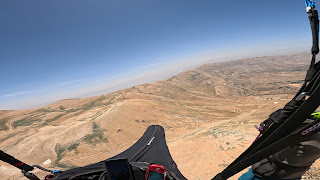Disclaimer:
Please note again… that tests will always differ with other sizes. At first, if flown with seatless harnesses, or must I say a completely different harness. Also if the same sizes are flown at different loads, lighter loads will get the weakest climb but will be penalized in control in heavy air or pushing through a heavy airmass. Bigger sizes have more gliding performance and also better climb in weak conditions. In my small tests, I always state the size, the total flying weight, and afterward IMHO, the optimum weight I found in that particular glider.
NIVIUK KLimber 3 P
Glider: Klimber 3 P size 21 for a certified weight range of 73-93, and NIviuk stated its optimum weight is 84-90.
Harness used: Woody Valley X-rated 6 size XL, slightly modified to fit my taste.
Test flown at 88, and 92 all up.
TEST:
Here is the new super light competition/hike and fly EN-D paraglider from NIVIUK.
After my test on the Advance Omega ULS, I will give my thoughts about the two gliders in the air.
At first, I cannot begin before I comment on the beautiful construction and details that were made on that Niviuk glider! Guys…really impressive! From the delivered light black/orange bag that holds the Klimber3 to that precise sewing of the N10 DOMINICO TEX CO that is used both on the upper and lower surface. The profile and diagonals are made from Porcher 70000 E91. It weighs less than 3.0 kg as announced! Here's the link for the details: [url]https://niviuk.com/en/klimber-3-p[/url]
 Laying it on the ground imposes gentle handling, as it has even lighter cloth than the Omega ULS. The Overall construction with the nitinol rods, and the risers, is nothing but excellent! A really beautiful piece of equipment!
Laying it on the ground imposes gentle handling, as it has even lighter cloth than the Omega ULS. The Overall construction with the nitinol rods, and the risers, is nothing but excellent! A really beautiful piece of equipment!
The Klimber 3 rises smoothly and effortlessly without any wind. It is one of the easiest 7-aspect ratio gliders to inflate.
Flying the Klimber 3 at 92 all up, in turbulent conditions gave me a complete idea about its usability. After a few hours, I think considering the 7 aspect ratio, the Klimber 3 P is an easy EN-D to handle. Of course, it needs slightly more active pilot control than the 2 liners C’s, but still easy for a D. It resembles the Omega ULS with perhaps a little more movement inside the glider. The Kimber 3 moves slightly more in itself but is still very easy to manage.
The brake length is shorter than the Omega ULS and as agile. The pressure on the brakes is slightly firmer than the Omega ULS, but still on the moderate side. I think that pressure is perfect.
I can say that the authority given by the brakes in turbulent air is quite nice, enabling the pilot to place it accurately in tiny cores. I liked the Omega ULS turning abilities, but I can tell you that I also enjoyed very much the shorter and sharper brake authority on the Klimber 3 as the responses were immediate and quite satisfying. I’m really lucky to be able to test-fly those new light gliders.
If you have flown the Artik R, and understand how it flies in the airmass, how it moves, how it enters thermals, then you will immediately understand the Klimber 3 behavior which has the exact feel but with more than 25 % workload. NIVIUK gliders have their own flying characteristics. The Klimber 3 like the Artik R, just slows slightly before entering the thermal, but the climb is quite nice for the category. In weak, and strong air, it is quite satisfying even at 92 all up on that size. If flown at 88, it will still fly as well but slows slightly more before entering.
Please remember that those super light gliders, are built with lots of optimizations to reduce weight to let you carry the little possible and let you extract the maximum of their abilities. So don’t expect them to perform like the X one for example! But they will deliver high-end performance for that special light EN-D class especially when you push the speed bar.
The speed travel of the Klimber 3 is quite long and delivers a higher top speed than the Omega ULS. The glide at 57 km/h is quite competitive. I think I will mix and update the 2 liner C comparison and add those lights D’s inside…Just to get an idea…(soon…)
While on the speed bar, the B steering has a moderate pressure similar to the Omega ULS and is quite efficient to keep the Klimber 3 on track. Flying at 75 % of the speed bar, the Klimber 3 profile seems taught, and the speed is quite usable.
Lots of stored energy inside the glider to play around, as it is addictive! but it is better not to get used to throwing it around too much!
Ears with outer B’s are efficient, stable, and reopen quickly.
Conclusion:
The look and the streamed line are very beautiful! the handling is sharp, precise, and joyful! It is a relatively easy 2 liner EN-D for that class of pilots. If carefully chosen, the complete package harness and glider, Vario, phone, helmet, water, and chocolate…will not exceed 7.5 kg! A blessing of perfection, if you can fit in your weight!
If you can…exciting moments await! Happy flights :-)







